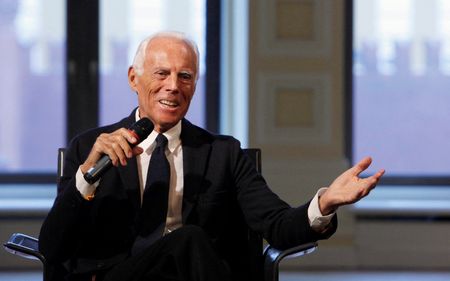By Elisa Anzolin
MILAN (Reuters) -Giorgio Armani established one of the world’s best-known fashion brands over the past five decades, and his death inevitably raises questions about the future of an Italian company whose independence he cherished.
Giorgio Armani, who died on Thursday at the age of 91, was the sole major shareholder of the company he set up with his late partner Sergio Galeotti in the 1970s and over which he maintained a tight rein – of both the creative and managerial aspects – until the very end.
He has left behind no children to inherit the business, which generated relatively stable revenue of 2.3 billion euros ($2.7 billion) in 2024, but whose profits had shrunk amid a broad industry recession.
Despite the slowdown, the company remains extremely attractive, say industry experts like Mario Ortelli, managing partner of luxury advisor firm Ortelli&Co.
“Could Giorgio Armani be an interesting target? The answer is absolutely yes — it’s one of the most recognised brands in the world, with a stylistic vision that is clearly and uniquely defined,” said Ortelli, adding however that a deal in the mid-term would be unlikely.
Over the years, the maker of popular unstructured suits received several approaches, including one in 2021 from John Elkann, scion of Italy’s Agnelli family, and another from luxury brand Gucci, when Maurizio Gucci was still at the helm.
Armani, who industry insiders say was particularly wary of French rivals, repeatedly ruled out any potential deal that would have diluted his control and refused to list his group on the stock market.
He put in place measures to ensure continuity and independence for his business, which he ran with trusted family members and a network of long-time colleagues.
He is survived by a younger sister, Rosanna, two nieces, Silvana and Roberta, and a nephew, Andrea Camerana, with the nieces and nephew all occupying important roles in the group. His right-hand man Pantaleo Dell’Orco is also regarded as a member of the family, and all five of them are possible heirs.
More clarity on his plans may emerge in the coming weeks, when Armani’s will is opened.
SECURING HIS LEGACY THROUGH A FOUNDATION
Giorgio Armani started to think of a plan to guarantee a smooth succession and to retain the company’s independence more than a decade ago, which led him to set up a foundation in 2016.
Its stated aim was to “safeguard the governance” of the Armani Group’s assets and ensure they remained consistent with principles that were “particularly important” to him.
The designer told Italian daily Corriere della Sera in 2017 that such a mechanism was needed to help his heirs to get along and to avoid the group being bought by others or broken up.
The foundation currently holds a symbolic 0.1% stake in the Milan-based group but after his death it was expected to get a bigger share, alongside the other heirs, he said in the same interview.
He also said that three nominees he had designated would run the foundation.
Armani also drafted new company bylaws due to take effect upon his death that outline future governing principles for those who inherit the group.
The bylaws call for a “cautious approach to acquisitions” and divide the company’s share capital into several categories with different voting rights and powers. It is not clear from the document how the different blocs of shares will be distributed.
They also state that any potential stock market listing would require backing from the majority of directors and could take place only “after the fifth year following the entry into force of this statute”.
SMALL BUT BEAUTIFUL
Commenting on past financial results, Giorgio Armani underlined his determination to continue to develop a business which is relatively small in scale compared with the French giant LVMH and other rivals such as Gucci-owner Kering and Italian luxury house Prada.
“I chose in any case to invest in projects of great symbolic and practical significance, which are fundamental to the future of the company,” he said in the results statement in July.
These investments included the renovation of flagship stores like its Madison Avenue building in New York and Emporio Armani in Milan, as well as spending on the new Palazzo Armani in Paris and taking e-commerce management in house.
Europe generates almost half of the Armani Group’s revenue, a far higher proportion than for other luxury brands, with the Americas and Asia Pacific accounting for around one fifth each.
The group had 570 million euros in net cash at the end of 2024 after stepping up investments.
ARMANI LIEUTENANTS COULD STEP UP
In his last interview to the Financial Times, Giorgio Armani said he wanted a gradual handover to his closest collaborators and family.
“My plans for succession consist of a gradual transition of the responsibilities that I have always handled to those closest to me… such as Leo Dell’Orco, the members of my family and the entire working team,” he told the FT’s How To Spend It supplement.
At a managerial level, the group will need to fill the chairman and CEO roles that were held by Giorgio Armani himself, with long-term veterans like Giuseppe Marsocci and Daniele Ballestrazzi among possible options.
Picking the right creative structure may be trickier.
Armani’s niece Silvana worked alongside her uncle in designing the women’s collections, while Dell’Orco collaborated with him on the men’s collections.
“Will the company have a single creative director? Or will there be multiple creative leads or line-specific directors? This is something Giorgio Armani has probably outlined in the guidelines that the foundation will implement,” said Ortelli.
($1 = 0.8559 euros)
(Reporting by Elisa Anzolin; Editing by Keith Weir, Ros Russell and Rosalba O’Brien)











